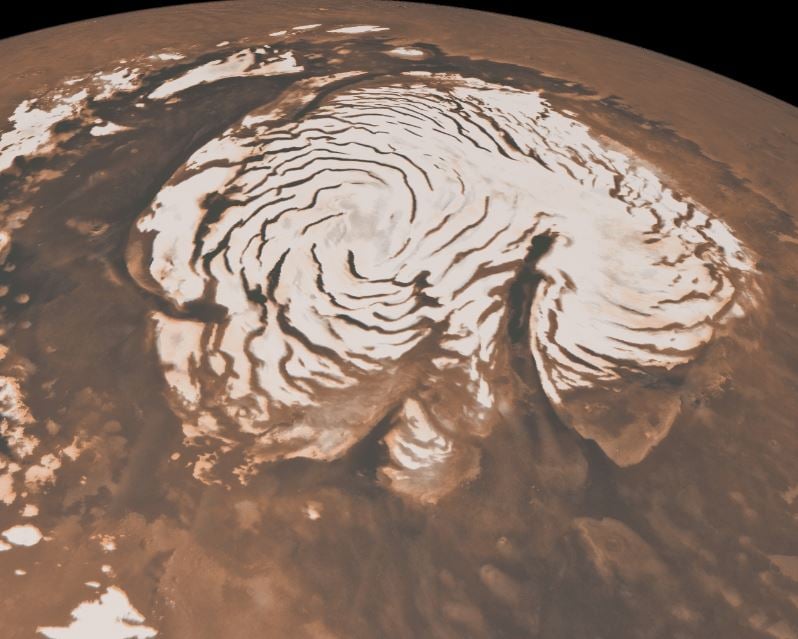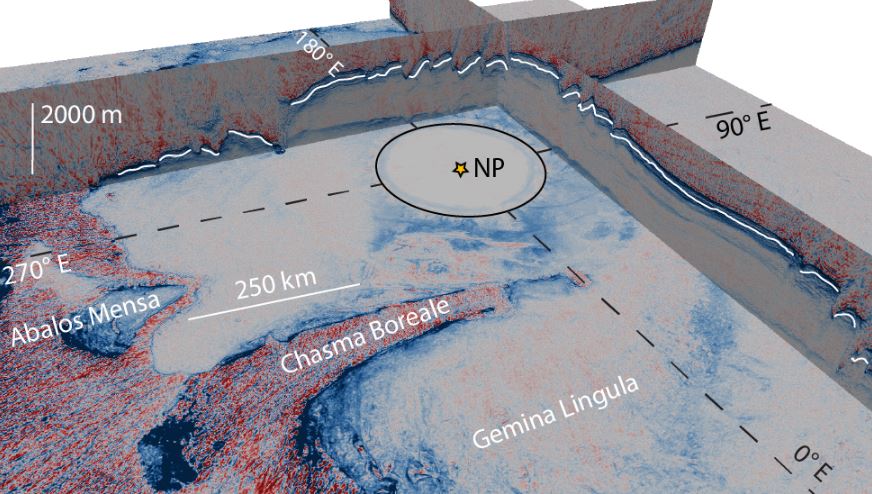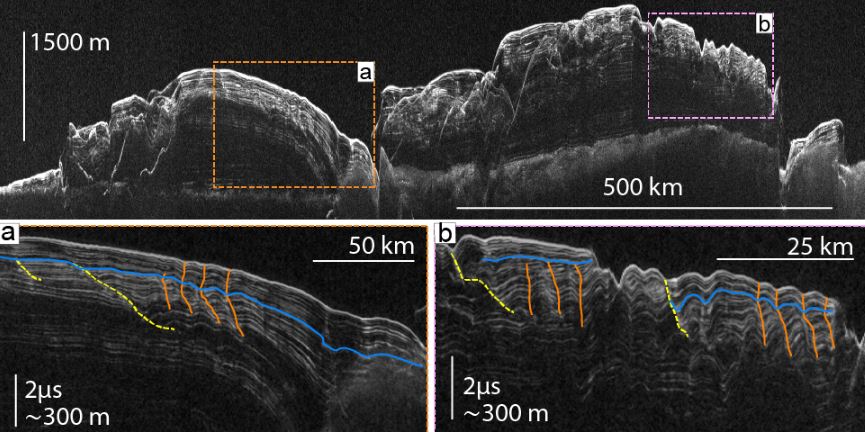Mars has ice ages just like Earth does, and is emerging from one now. After studying radar measurements of the Red Planet’s polar ice caps, scientists found that following multiple rounds of climate change it is emerging from a Martian ice age.
Models have often suggested that Mars has been through several ice ages in the past, however, a lack of empirical data meant it was impossible to confirm this, that is, until now.
A team of scientists, led by the Southwest Institute (SwRI) in San Antonio, Texas, gathered and analysed radar data collected by NASA’s Mars Reconnaissance Orbiter. According to polar deposits on the Red Planet, they found evidence of several ice ages.
 Mosaic image, produced with the High Resolution Stereo Camera onboard ESA’s Mars Express spacecraft, showing spiral features that were used in interpreting the climate signal of ice age advancement and retreat. (Image: NASA/JPL-Caltech/MSSS)
Mosaic image, produced with the High Resolution Stereo Camera onboard ESA’s Mars Express spacecraft, showing spiral features that were used in interpreting the climate signal of ice age advancement and retreat. (Image: NASA/JPL-Caltech/MSSS)
Mars’ & Earth’s ice ages driven by similar processes
In the journal Science, the scientists explained that Mars’ ice ages are driven by similar processes to those that cause ice ages on Earth – long term changes in the planet’s tilt and orbit, which affect how much solar radiation each latitude receives.
Lead author, Dr. Isaac Smith, a postdoctoral researcher at SwRI, said:
“We found an accelerated accumulation rate of ice in the uppermost 100 to 300 meters of the polar cap. The volume and thickness of ice matches model predictions from the early 2000s.”
“Radar observations of the ice cap provide a detailed history of ice accumulation and erosion associated with climate change.”
The Red Planet experiences seasonal cycles and annual rotation, as well as longer cycles, that affect ice distribution, just like on Earth.
 This 3-D perspective view of Mars’ polar ice cap was used by scientists to look for signs of climate change. (Image: swri.org. Credit: Fritz Foss and Nathaniel Putzig)
This 3-D perspective view of Mars’ polar ice cap was used by scientists to look for signs of climate change. (Image: swri.org. Credit: Fritz Foss and Nathaniel Putzig)
However, the longer cycles are likely to be more pronounced on Mars, because its tilt changes significantly – by up to 60 degrees – on timescales of hundreds of thousands to millions of years.
Earth’s tilt, by comparison, only varies by approximately 2 degrees over the same period. This greater variability on Mars determines how much sunlight reaches a given spot on the surface, and thus the stability of ice at all latitudes.
Mars very different in the past
Dr. Smith said:
“Because the climate on Mars fluctuates with larger swings in axial tilt, and ice will distribute differently for each swing, Mars would look substantially different in the past than it does now.”
“Furthermore, because Mars has no oceans at present, it represents a simplified ‘laboratory’ for understanding climate science on Earth.”
Detailed ice thickness measurements reveal that approximately 87,000 cubic kilometres of ice have accumulated in the North and South Poles since the end of the last ice age, which occurred about 370,000 years ago. Most of the material accumulated on Mar’s North Pole.
This volume, if spread uniformly across the planet’s surface, would consist of a layer 60 centimetres thick.
 The top 100-to-300 metre layers of ice show a stark change in properties between an inter-glacial period and an ice age. In the highlighted boxes, below the blue line, layers show migration of spiral features towards the left (orange and yellow lines). Above the blue line, those features disappear or reverse migration direction. (Image: swri.org)
The top 100-to-300 metre layers of ice show a stark change in properties between an inter-glacial period and an ice age. In the highlighted boxes, below the blue line, layers show migration of spiral features towards the left (orange and yellow lines). Above the blue line, those features disappear or reverse migration direction. (Image: swri.org)
The authors say that these results provide a means to understand the accumulation history of deposits on the Martian poles in relation to the planet’s movements, such as axial tilt, orbital eccentricity, and rotation around the Sun.
This study’s results will support modelling efforts to understand the Martian climate, looking at ice movements from poles to mid-latitudes during climate cycles.
Dr. Smith said:
“Studying ice on Mars also is important to the future of human exploration of the Red Planet. Water will be a critical resource for a martian outpost.”
In an Abstract that describes the main article in the journal, the scientists wrote:
“The majority of the material accumulated at the north pole. These results provide both a means to understand the accumulation history of the polar deposits as related to orbital Milankovitch cycles and constraints for better determination of Mars’ past and future climates.”
Citation: “An ice age recorded in the polar deposits of Mars,” Isaac B. Smith1, Nathaniel E. Putzig, John W. Holt and Roger J. Phillips. Science, Vol. 352, Issue 6289, pp. 1075-1078. DOI: 10.1126/science.aad6968.
